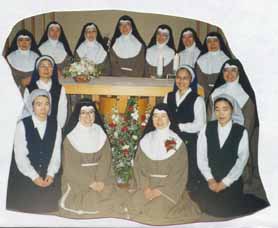Liturgy (continued)

|
Japanese culture is taken up with death. The most important thing parents want is to have their children bury them. That is why it was a heroic decision for our community of six, in 1989, to choose to adopt Poor Clare constitutions which observe the traditional enclosure, not allowing home visits. It wasn't easy, but as one Sister said: "If I say 'no' to this, I would be denying the Resurrection - as if I didn't believe I would see my father again after death." with this choice, truly the enclosure of our hearts was established, for, apart from the desire to be with a parent at death, there was nothing else to pull our hearts back to the world. A great peace enfolded us as we entrusted our cares about our parents to the Lord.
On the anniversary of a parent's death we pray for him or her at Lauds and at Mass. Pictures of deceased relatives, friends and benefactors are displayed in the Choir in August, when the Japanese celebrate their festival for the dead, and again on November 2, along with the relics of the saints from All Saints' Day. All Souls of the Order is a chance to commemorate members of the Franciscan Family whom we have known.
Just recently we have decided to have a Mass offered each month for the parents of the Sisters, both living and dead. On a Sister's profession day a picture of her deceased parent(s), if any, is placed by the statue of St. Clare in the public chapel.
 |
 |
 |